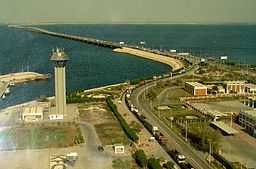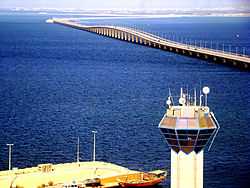King Fahd Causeway
| King Fahd Causeway جسر الملك فهد | |
|---|---|
|
The King Fahd Causeway as seen from space | |
| Coordinates | 26°10′57″N 50°20′09″E / 26.18250°N 50.33583°ECoordinates: 26°10′57″N 50°20′09″E / 26.18250°N 50.33583°E |
| Carries | Motor vehicles |
| Crosses | Gulf of Bahrain |
| Locale |
|
| Official name | King Fahd Causeway |
| Other name(s) | Bahrain Bridge |
| Maintained by | King Fahd Causeway Authority |
| Website | www.kfca.com.sa |
| Characteristics | |
| Total length | 25 km (16 mi) |
| Width | 23 m (75 ft) |
| History | |
| Opened | 12 November 1986 |
| Statistics | |
| Toll |
SAR 20 (Small Vehicles) SAR 30 (Light Trucks & Small Bus) SAR 50 (Large Buses) SAR 3 per ton (Trucks) |

The King Fahd Causeway (Arabic: جسر الملك فهد, Jisr al-Malik Fahd) is a series of bridges and causeways connecting Saudi Arabia and Bahrain. The idea of constructing the causeway was based on improving the links and bonds between Saudi Arabia and Bahrain.[1] Surveying of the maritime began in 1968, and construction began in 1981 and continued until 1986, when it was officially opened to the public.
History
The idea of building a bridge linking the Kingdom of Bahrain to the Eastern region of the Kingdom of Saudi Arabia had been enticing the two kingdoms for generations. The idea was born out of King Saud's wish to nurture and further solidify the brotherly bond between the two Kingdoms, during an official visit to the State of Bahrain in 1954.
In 1965, the desire to construct the causeway began to take form officially when Shaikh Khalifah ibn Sulman Al Khalifah the Prime Minister of the State of Bahrain paid a courtesy visit to King Faisal and the king expressed his wish to have the causeway constructed.
In 1968, both countries formed a joint committee to assess the financial undertaking required for the task. As a result the World Bank was requested by the committee to contribute their assistance in methods of implementation of the mammoth-sized project. This required taking into account the environmental and geographical aspects of the Saudi-Bahrain region.
In the summer of 1973, King Faisal, in a meeting which included Amir Shaikh Isa bin Salman Al Khalifa as well as the then prince, Fahd bin Abdul Aziz and Shaikh Khalifa bin Salman Al Khalifa, suggested that committee overlook the economic and financial aspects of the project and concentrate on the actual construction of the causeway.
In 1975, the World Bank submitted its study and advice after seeking assistance from specialist international expertise in studying the geographic, environmental factors and maritime currents.
In the spring of 1976, during a visit by King Khalid bin Abdul Aziz to Shaikh Isa bin Salman Al Khalifa, the two monarchs agreed to set up a ministerial committee from the two countries to work on the implementation of the project.
.jpg)
On 8 July 1981, Mohammed Aba Al-Khail, the then minister for Finance and National Economy of Saudi Arabia and Yousuf Ahmed Al-Shirawi, the then minister of Industrial Development in Bahrain signed an agreement to start construction on the maritime causeway.
On 11 November 1982, King Fahd bin Abdul Aziz and Shaikh Isa bin Salman Al Khalifa unveiled the curtain on the Memorial Plaque during a formal ceremony attended by the leaders of the GCC states marking the beginning of the project.
On 11 April 1985, Shaikh Khalifa bin Salman Al Khalifa, the Prime Minister of Bahrain pressed the button required to install the final part of the box bridges thereby finally linking Saudi mainland with the island of Bahrain.
On 26 November 1986, the causeway was officially inaugurated in the presence of the Custodian of the Two Holy Mosques, King Fahd bin Abdul Aziz of Saudi Arabia and His Royal Highness Shaikh Isa bin Salman Al Khalifa, Emir of the State of Bahrain, with the latter consenting heartily to naming the bridge King Fahd Causeway.[1]
As of 2010, it is estimated that number of vehicles using the causeway is about 25,104 daily. The total number of travelers across the causeway from both countries in the year 2010 was 19.1 million passengers, or an average of 52,450 passengers per day.[2]
Construction details
The project cost a total of US$800 million (SAR3 billion). One of the major contractors of the project was Ballast Nedam, based in the Netherlands. It is unclear how many workers were engaged in the construction of the Causeway.[3] The four-lane road is 25 km (16 mi) long and approximately 23 m (75 ft) wide, and was built using 350,000 m3 (12,000,000 cu ft) of concrete along with 47,000 metric tonnes of reinforced steel. The causeway was constructed in three segments starting from Saudi Arabia:
- From Al-Aziziyyah, south of Khobar, to the Border Station on Passport Island
- From the Border Station to Nasan Island in Bahrain
- From Nasan island to the Al-Jasra, west of Manama, on the main island of Bahrain[2]
Strict quality control regimes were established to ensure durability of the structure. In this regard, Al Hoty Stanger Ltd, the premier testing laboratory with SASO accreditation, was contracted to perform relevant civil materials testing on both sides of the causeway project.
Border station
The Border Station is located on embankment No.4, which, with a total area of 660,000 square meters, is the biggest of all embankments. This artificial island is known as Passport Island or Middle Island. The buildings of King Fahd Causeway Authority and other government Directorates were erected on the Border Station, as well as two mosques, two Coast Guard towers and two 65 m (213 ft) high tower restaurants. The border station also has extensive landscaping all around the islands in addition to the services and road stations.
The Border Station was designed as two connected islands, with the west side designated as Saudi Arabian and the east as Bahraini.[4] The Saudi side of the Border Station has outlets of McDonald's & Kudu (restaurant).

Expansion
On 6 July 2010, Saudi newspapers quoted King Fahd Causeway Authority chief Bader Abdullah Al-Otaishan as saying that the King Fahd Causeway was to undergo a major expansion projected to cost $5.3 million. It was announced that the number of departure lanes would be increased from 10 to 17 and the number of arrival lanes from 13 to 18 on both sides. The renovation includes construction of a commercial center on the Bahraini side.
"It will have a number of restaurants, coffee shops, a grocery shop, telephone stalls and a shop to meet travelers’ needs," said Al-Otaishan. "We saw that there was a need for such a center to assist travelers.". With points including climate controlled washrooms and meeting places, the average traveler can be better facilitated. He said work was under way and that the center would be completed by the first quarter of the next year. A Bahraini health center was also being built to serve travelers and causeway staff. "It will feature an emergency room and ambulance to serve whoever is using the causeway — travelers or employees," he said, noting a Saudi health center was also planned for 2011. A security checkpoint near the Bahraini entrance of the causeway was to be added to the checkpoint near the Saudi entrance. "It will allow us to control the causeway and close it," Al-Otaishan said.
The project also included expanded public utilities such as washrooms and mosques on both sides of the causeway, to be completed by the end of 2011. A separate project, to revamp the two tower restaurants, one Saudi and one Bahraini, was announced. The renovation would not alter the towers' historic appearance. Al-Otaishan told local newspapers that tenders for the project on the Saudi side had already been approved, with the Bahraini side set to follow suit.[2]
See also
References
External links
| Wikimedia Commons has media related to King Fahd Causeway. |
